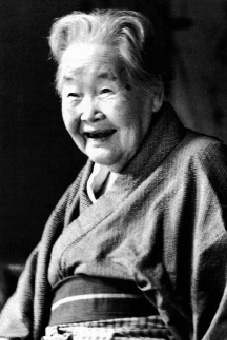Sue Sumii
Sue Sumii, the champion of Japan’s untouchables, died on June 16th 1997, aged 95
When Sue Sumii was six, the Emperor Meiji visited the village where she lived, near Nara. After he left, the villagers scrabbled for souvenirs: cigarette butts adorned with the imperial seal, anything that the god-king might have touched. One farmer went into the lavatory the emperor had used and reverentially scraped out a sample of sacred stool. For the child the incident was a revelation. “If the emperor shits,” Mrs Sumii wrote later, “it must mean he eats, too. In that case, he’s no different at all from me.” She spent most of her adult life exposing the idiocy of Japan’s class system, and inspiring sympathy for its most despised victims: the untouchable caste known as burakumin.
The subject is avoided in polite society, but Japan has had untouchables – similar in some ways to the harijan of India or the paekchong of Korea – since at least the 13th century. Buddhism bars the killing of animals, and Japan’s native Shinto creed rules that contact with dead flesh is defiling; so butchers, leatherworkers and gravediggers have traditionally been confined to ghettoes and shunned. In feudal times, the eta (much filth), as they were called, were banned from socialising with other Japanese and sometimes forced to wear leather patches on their sleeves to mark them out as unclean. In 1859, when an untouchable was murdered in a brawl, the judge ruled that the murderer could not be punished unless he was allowed to kill six more untouchables: an eta life was worth a seventh of that of an “ordinary” Japanese.
Although segregation was legally ended in 1871, discrimination persists. There are more than 1m burakumin (hamlet people) in Japan today, mostly concentrated in the Osaka region. They are distinguishable from other Japanese only as a result of where they (or their ancestors) live. Companies buy (illegal) lists of buraku addresses to avoid hiring them, and “respectable” families pay private detectives to check that potential in-laws do not come from untouchable stock. Buraku household income is perhaps 60% of the Japanese average.
Sue Sumii was not a burakumin. But she lived near a ghetto, and recorded and decried its residents’ plight in speeches, articles, and in a series of novels collectively entitled “The River with No Bridge”. This sad, tender saga, begun in Mrs Sumii’s 50s, after her husband died, tells of the trials of a family of sandal-makers: the poverty, the taunts, the shame of trying to buy food when shopkeepers will not touch coins that have been handled by an outcast. When a fire breaks out in their village, the neighbours stand around remarking how an eta fire stinks, instead of helping. In a real-life reflection of Mrs Sumii’s story, the areas worst hit by the fires that followed the Kobe earthquake of 1995 were the narrow streets and wooden shacks where the burakumin lived. Local people claimed that the fire brigade doused buraku flames last.
Extraordinarily, given Mrs Sumii’s controversial subject matter and radical politics, the seven volumes of “The River with No Bridge” have sold more than 8m copies, and been turned into two films. At no small risk to herself, Mrs Sumii made links between the imperial family’s

wealth and its subjects’ wretchedness, and between the shared religious roots of emperor-worship and scorn for the burakumin.
For many Japanese, Mrs Sumii’s writings were their sole window on the untouchables. The subject is almost never aired in the Japanese media, and foreign books that touch on the buraku problem have all references to it deleted when they are translated into Japanese. Japan Airlines once pulped an edition of its in-flight magazine because of a brief mention of the topic in an article on private investigators.
Partly, the silence that enshrouds buraku affairs reflects editors’embarrassment at the existence of a tormented minority in their supposedly harmonious society. But, also, it is because campaigners for buraku rights have been known to fight prejudice with their boots and fists. Publishers of books considered offensive have had their offices invaded and their bookshops picketed by bellowing firebrands from the Buraku Liberation League. Since few papers or television companies can keep pace with the league’s ever-shifting decrees about which words are acceptable when referring to burakumin, and which are not, most choose to avoid the subject entirely. Mrs Sumii’s work was the only conspicuous exception to this rule.
It should be said in fairness that life for the burakumin has improved in the past two decades. Special grants have made the ghettoes less slummy, and three-quarters of burakumin now manage to marry non-buraku partners. Some achieve this by moving house, changing their names, and concealing their origins; but other “mixed” weddings reflect a waning of medieval prejudice. If anyone deserves the credit for this, it must surely be Sue Sumii. She was working on an eighth volume of her saga when she died.